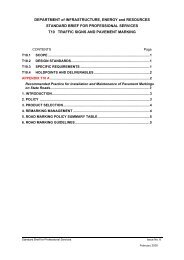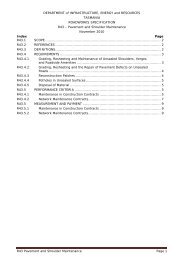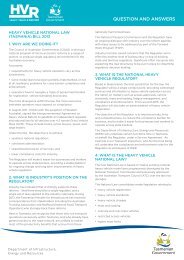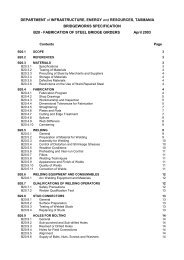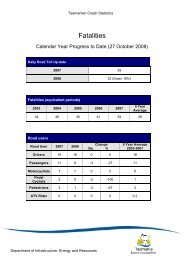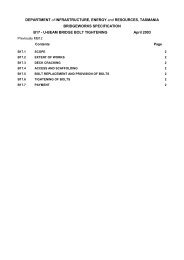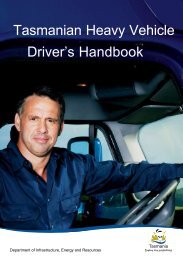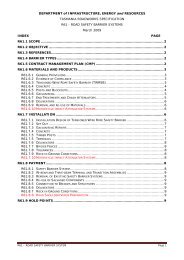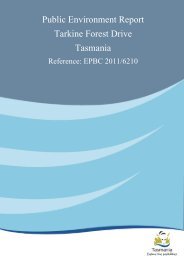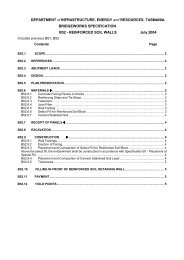Operator Accreditation Manual - Transport
Operator Accreditation Manual - Transport
Operator Accreditation Manual - Transport
You also want an ePaper? Increase the reach of your titles
YUMPU automatically turns print PDFs into web optimized ePapers that Google loves.
PASSENGER<br />
TRANSPORT<br />
SERVICES<br />
OPERATOR ACCREDITATION<br />
<strong>Manual</strong><br />
Department of Infrastructure, Energy and Resources<br />
Passenger <strong>Transport</strong> Policy Branch
Produced by<br />
Passenger <strong>Transport</strong> Policy Branch<br />
Department of Infrastructure,<br />
Energy and Resources<br />
GPO BOX 936<br />
Hobart Tasmania 7001<br />
Phone 03 6233 5347<br />
Email: operator.accreditation@dier.tas.gov.au<br />
This manual is available online at:<br />
www.transport.tas.gov.au/operator_information
Introduction 2<br />
MODULE 1: ADMINISTRATION 5<br />
1.1 Responsible Person 6<br />
1.2 Record keeping 7<br />
1.3 <strong>Accreditation</strong> details 8<br />
1.4 Vehicle registration 8<br />
MODULE 2: VEHICLE MANAGEMENT 9<br />
2.1 Roadworthiness inspections 11<br />
2.2 Pre-departure inspections 12<br />
2.3 Fault reporting and clearance 13<br />
2.4 Safety inspections 14<br />
2.5 Emergency management 14<br />
MODULE 3: DRIVER ADMINISTRATION 15<br />
3.1 Initial check of driver qualifications 17<br />
3.2 Driver records 19<br />
3.3 Driver monitoring 20<br />
3.4 Passenger behaviour management 21<br />
3.5 Reportable incident management 22<br />
Best Practice Driver Code of Behaviour 23<br />
Glossary 25<br />
Passenger <strong>Transport</strong> Services <strong>Operator</strong> <strong>Accreditation</strong> <strong>Manual</strong> 1
INTRODUCTION<br />
INTRODUCTION<br />
Who is this <strong>Manual</strong> for?<br />
The Passenger <strong>Transport</strong> Services <strong>Operator</strong><br />
<strong>Accreditation</strong> <strong>Manual</strong> is for passenger transport<br />
service operators who are required to hold operator<br />
accreditation in order to operate their service.<br />
If you are unsure about whether you need to be<br />
accredited, you should refer to the Passenger<br />
<strong>Transport</strong> Services <strong>Operator</strong> <strong>Accreditation</strong><br />
Guide and the online self-assessment tool at<br />
www.transport.tas.gov.au/onlinetoollink.<br />
If you operate a taxi service you should refer to the<br />
manual for taxi operators.<br />
What is in this <strong>Manual</strong>?<br />
This manual outlines the service, security and<br />
operational standards that passenger transport<br />
services operators must comply with in order to<br />
be granted, and to retain, operator accreditation.<br />
These <strong>Accreditation</strong> Standards are the minimum<br />
standards expected of all passenger transport<br />
service operators and include requirements to:<br />
• keep relevant records relating to your service;<br />
• ensure that your vehicles are safe and<br />
inspected regularly; and<br />
• ensure that your drivers are appropriately<br />
qualified and suitable people to be driving your<br />
vehicles.<br />
If you can demonstrate that you are doing<br />
everything outlined in the <strong>Accreditation</strong> <strong>Manual</strong>, you<br />
can expect to be assessed as complying with the<br />
minimum <strong>Accreditation</strong> Standards.<br />
What are the <strong>Accreditation</strong><br />
Modules?<br />
The <strong>Accreditation</strong> Standards are divided into three<br />
modules, which are set out in the manual. Some of<br />
the modules will vary slightly for different types of<br />
services.<br />
Module 1: General Administration<br />
This module includes record keeping, and<br />
ensuring that you keep DIER up to date with<br />
the contact details and other details about<br />
your service.<br />
Module 2: Vehicle Management and<br />
Administration<br />
This module includes regular inspections, a fault<br />
reporting system and emergency management<br />
procedures.<br />
Module 3: Driver Management and<br />
Administration<br />
This module includes checks you need<br />
to undertake before you engage a driver,<br />
records you need to keep, and ongoing<br />
monitoring of driver qualifications. It also includes<br />
procedures that drivers need to be aware of,<br />
including passenger behaviour management,<br />
reportable incidents management and<br />
emergency management.<br />
2 Passenger <strong>Transport</strong> Sevices <strong>Operator</strong> <strong>Accreditation</strong> <strong>Manual</strong>
Do I have to comply with<br />
everything in the <strong>Manual</strong>?<br />
If you operate a passenger transport service,<br />
including bus, luxury hire car, restricted hire vehicle<br />
etc, you must comply with all of the minimum<br />
requirements in all three modules, unless you are<br />
eligible to hold Category B or C accreditation as<br />
outlined below.<br />
If you operate a taxi service you should refer to the<br />
manual for taxi operators.<br />
• Category B accreditation is only available and<br />
only applies to operators of passenger transport<br />
services operated using a vehicle with 13 or more<br />
seats, to which one or more components of the<br />
three-part test do not apply.<br />
• Category C accreditation is only available and<br />
only applies to operators of passenger transport<br />
services operated using a vehicle with 10, 11 or<br />
12 more seats, to which one or more components<br />
of the three-part test do not apply.<br />
If you operate a small passenger vehicle to provide<br />
a service that is not a passenger transport service<br />
(that is, where one or more components of the<br />
three-part test do not apply), you may apply for<br />
voluntary accreditation.<br />
The requirements for you to confirm that your<br />
drivers hold Ancillary Certificates (explained in<br />
Standard 3.1) and to check that each driver holds<br />
an Ancillary Certificate every year (explained<br />
in Standard 3.3) are not mandatory if you are<br />
eligible for Category B or C accreditation or for<br />
voluntary accreditation. These are the only optional<br />
requirements. You must comply with all other<br />
requirements in all three modules.<br />
If you are unsure whether your service is eligible<br />
for Category B or C accreditation or for voluntary<br />
accreditation, you should refer to the Passenger<br />
<strong>Transport</strong> Services <strong>Operator</strong> <strong>Accreditation</strong> Guide<br />
and the online assessment tool at www.transport.<br />
tas.gov.au/onlinetoollink<br />
If you are not eligible for Category B or C<br />
accreditation or voluntary accreditation, you must<br />
hold Category A accreditation and you must comply<br />
with all of the minimum requirements in all three<br />
modules.<br />
Can I do more than what is in<br />
the <strong>Manual</strong>?<br />
Yes. The <strong>Accreditation</strong> Standards outlined in this<br />
manual are the minimum requirements you must<br />
meet in order to be assessed as compliant. These<br />
are the standards your service will be assessed<br />
against in an audit.<br />
If you wish to put additional systems and processes<br />
in place that suit the needs of your business, you<br />
are free to do this. In some modules, some “Best<br />
Practice” principles are suggested for you to adopt<br />
if you wish to do so. These are encouraged, but are<br />
not mandatory and will not be assessed in the audit.<br />
Forms<br />
Some standards refer to forms that you can use<br />
or adapt to the needs of your service. The forms<br />
are provided in a document that accompanies this<br />
manual.<br />
Passenger <strong>Transport</strong> Services <strong>Operator</strong> <strong>Accreditation</strong> <strong>Manual</strong> 3
This page is intentionally blank<br />
4 Passenger <strong>Transport</strong> Sevices <strong>Operator</strong> <strong>Accreditation</strong> <strong>Manual</strong>
MODULE 1:<br />
ADMINISTRATION<br />
Introduction<br />
This module explains the administration requirements of the<br />
Passenger <strong>Transport</strong> Services <strong>Operator</strong> <strong>Accreditation</strong> Scheme.<br />
There are four standards in the Administration Module.<br />
The standards are:<br />
1.1 RESPONSIBLE PERSON<br />
1.2 RECORD KEEPING<br />
1.3 ACCREDITATION DETAILS<br />
1.4 VEHICLE REGISTRATION<br />
Passenger <strong>Transport</strong> Services <strong>Operator</strong> <strong>Accreditation</strong> <strong>Manual</strong> 5
STANDARD 1.1<br />
RESPONSIBLE PERSON<br />
For businesses, partnerships and other<br />
organisations only<br />
If you are accredited in your own name (that is, as<br />
an individual person), Standard 1.1 does not apply<br />
to you. You are considered to be the Responsible<br />
Person for your service.<br />
Requirements for Standard 1.1<br />
If your accreditation is for a business, a partnership,<br />
or another type of organisation you must appoint<br />
an individual aged over 18 years as your service’s<br />
Responsible Person for your operator accreditation.<br />
(Section 18 of the Passenger <strong>Transport</strong> Services<br />
Act 2011.)<br />
The person you appoint will depend on the type of<br />
organisation that operates the transport service, as<br />
shown below:<br />
Type of organisation<br />
Government Body<br />
Responsible person<br />
A member or senior<br />
employee<br />
You must nominate the Responsible Person in your<br />
application for accreditation.<br />
The Responsible Person’s role is to:<br />
• be the primary contact for DIER about the<br />
safety, security and other matters relating to<br />
your service;<br />
• oversee the day to day safety, security and<br />
related matters in respect of your service; and<br />
• be responsible for ensuring that your business<br />
complies with the Passenger <strong>Transport</strong><br />
Services <strong>Operator</strong> <strong>Accreditation</strong> Scheme and<br />
the legislation.<br />
The Responsible Person may delegate any of the<br />
duties they have to perform under the legislation<br />
or the accreditation scheme to another person.<br />
However, the Responsible Person is legally<br />
responsible for ensuring that the duties are<br />
carried out correctly. The Responsible Person<br />
is the person that the <strong>Transport</strong> Commission<br />
will contact if your service does not meet these<br />
requirements.<br />
If the Responsible Person ceases to have that role,<br />
you must inform the <strong>Transport</strong> Commission who<br />
the new Responsible Person is, in writing, within<br />
14 days (refer to Standard 1.3).<br />
Partnership<br />
Incorporated body<br />
Unincorporated body<br />
One of the partners<br />
An officer or an<br />
employee<br />
A member<br />
6 Passenger <strong>Transport</strong> Sevices <strong>Operator</strong> <strong>Accreditation</strong> <strong>Manual</strong>
STANDARD 1.2<br />
RECORD KEEPING<br />
Requirements for Standard 1.2<br />
You must ensure that the records and documents<br />
that you are required to keep for the Passenger<br />
<strong>Transport</strong> <strong>Operator</strong> Services <strong>Accreditation</strong> Scheme<br />
(refer below) are always:<br />
► Kept up to date<br />
► Stored in a readily accessible and secure place<br />
► Available for inspection on demand by an<br />
<strong>Accreditation</strong> Auditor, DIER officer or a <strong>Transport</strong><br />
Inspector.<br />
Which records must be kept?<br />
You are required to keep the following records<br />
and documents for the Passenger <strong>Transport</strong><br />
<strong>Operator</strong> <strong>Accreditation</strong> Scheme for a minimum of<br />
three (3) years:<br />
Standard Reference<br />
Document<br />
<strong>Accreditation</strong> Certificate issued by the <strong>Transport</strong> Commission<br />
National Police Certificate for your service’s Responsible Person<br />
Passenger <strong>Transport</strong> Services <strong>Operator</strong> <strong>Accreditation</strong> <strong>Manual</strong><br />
1.4 List or register of all the vehicles that you use to operate your service<br />
Registration documents for all vehicles<br />
2.1 All roadworthiness inspection reports for each vehicle<br />
2.2 All completed pre-departure inspection checklists for each vehicle<br />
2.3 All fault reports for each vehicle<br />
Records of repairs undertaken as a result of faults identified<br />
2.4 Records of major vehicle safety inspections<br />
2.5 Emergency management procedures<br />
3.2 Driver register, including driver acknowledgement of awareness of:<br />
• Pre-departure inspection procedures (Standard 2.2)<br />
• Fault reporting system (Standard 2.3)<br />
• Emergency management procedures (Standard 2.5)<br />
• Passenger behaviour management procedures (Standard 3.4)<br />
• Reportable incident management procedures (Standard 3.5)<br />
3.2 Driver file or other filing method to keep documents relevant to each driver’s<br />
engagement or employment<br />
3.3 Record of having checked the details held in your driver register for each<br />
driver to ensure that each driver still holds a current driver licence and<br />
Ancillary Certificate<br />
3.4 Passenger behaviour management procedures<br />
3.5 Reportable incident management procedures<br />
Passenger <strong>Transport</strong> Services <strong>Operator</strong> <strong>Accreditation</strong> <strong>Manual</strong> 7
STANDARD 1.3<br />
MAINTAINING<br />
ACCREDITATION<br />
DETAILS<br />
Requirements for Standard 1.3<br />
►<br />
You must have a method in place to ensure that<br />
the <strong>Transport</strong> Commission is informed if certain<br />
events occur, or if any relevant details relating to<br />
your service change, as outlined below.<br />
1. Events you must inform the <strong>Transport</strong><br />
Commission about<br />
There are certain events that you are legally<br />
obliged to inform the <strong>Transport</strong> Commission about.<br />
These are:<br />
• If you are accredited in your own name, and<br />
are charged with a serious offence* you must<br />
notify the Commission within 14 days.<br />
• If your service’s Responsible Person is charged<br />
with a serious offence* he or she must notify<br />
the Commission within 14 days.<br />
• If your Responsible Person ceases to have<br />
that role, you must notify the Commission of<br />
this and advise the Commission of the new<br />
Responsible Person within 14 days.<br />
* A serious offence is an offence prescribed in the<br />
Passenger <strong>Transport</strong> Services Act. These offences<br />
are outlined in the Glossary.<br />
2. Changes of details you must advise the<br />
<strong>Transport</strong> Commission of<br />
You must inform the <strong>Transport</strong> Commission of any<br />
changes to your accreditation details including:<br />
• Partnership, business or company name<br />
• Business and postal addresses<br />
• Telephone and fax numbers and email address<br />
• Contact details of your Responsible Person<br />
• The type of passenger transport service you<br />
are operating<br />
• If you are operating large passenger vehicles<br />
(10+ seats), the size of the vehicle(s) being<br />
used to operate the passenger transport<br />
service<br />
• Any other relevant information advised to you<br />
by the Commission<br />
STANDARD 1.4<br />
VEHICLE<br />
REGISTRATION<br />
Requirements for Standard 1.4<br />
► You must keep a list or register of all the vehicles<br />
that you use to operate your service, including<br />
the carrying capacity of each vehicle, the<br />
registration details of each vehicle and, where<br />
there is a legislated maximum age of operation<br />
for your vehicle (luxury hire cars), the date from<br />
which each vehicle can no longer be used. Form<br />
1.4 is an example of a vehicle register.<br />
► The vehicles you use to provide your passenger<br />
transport service must be currently and correctly<br />
registered and you must keep the current<br />
registration documents for each vehicle.<br />
► The vehicles you use to provide your passenger<br />
transport service must have the correct Motor<br />
Accidents Insurance Board (MAIB) premium paid<br />
for the use of the vehicle.<br />
MAIB Premium Classes relevant to vehicles<br />
providing passenger transport services<br />
Class 6 Luxury hire car<br />
Class 7 Vehicle with more than<br />
16 seats<br />
Class 16<br />
Medium passenger vehicle<br />
(vehicle with 16 seats or less,<br />
including a restricted hire<br />
vehicle but not a taxi or luxury<br />
hire car)<br />
8 Passenger <strong>Transport</strong> Sevices <strong>Operator</strong> <strong>Accreditation</strong> <strong>Manual</strong>
MODULE 2:<br />
VEHICLE<br />
MANAGEMENT<br />
Introduction<br />
To ensure that your service is safe, it is important that your<br />
vehicle(s) are safe and roadworthy at all times.<br />
This Module explains the requirements of the Passenger<br />
<strong>Transport</strong> Services <strong>Operator</strong> <strong>Accreditation</strong> Scheme relating<br />
to vehicle management.<br />
Vehicle Management Standards<br />
There are five standards in the Vehicle Management<br />
Module. These relate to inspections, fault management,<br />
and emergency management as listed below:<br />
2.1 ROADWORTHINESS INSPECTIONS<br />
2.2 PRE-DEPARTURE INSPECTIONS<br />
2.3 FAULT REPORTING AND CLEARANCE<br />
2.4 SAFETY INSPECTIONS<br />
2.5 EMERGENCY MANAGEMENT<br />
Passenger <strong>Transport</strong> Services <strong>Operator</strong> <strong>Accreditation</strong> <strong>Manual</strong> 9
There are a number of regular inspections that apply to<br />
vehicles used to provide passenger transport services.<br />
Some of these are required by law and others form<br />
part of the <strong>Accreditation</strong> Standards. These must all be<br />
included in your vehicle management system under<br />
Module 2.<br />
The schedules are outlined below:<br />
Activity Timing Carried out by Reference<br />
Pre-departure<br />
inspection<br />
Before the first departure<br />
of the day<br />
Driver, employee, operator<br />
or person nominated by<br />
the Responsible Person<br />
Standard 2.2<br />
Roadworthiness<br />
inspection<br />
6 or 12 monthly,<br />
depending on the vehicle<br />
Approved Inspection<br />
Station<br />
Standard 2.1<br />
Safety inspection Every 6 months or 10,000<br />
km, whichever comes first<br />
Qualified mechanic<br />
or person approved<br />
by registered training<br />
organisation<br />
Standard 2.4<br />
Documents to keep<br />
You must keep a record of all of the relevant<br />
documentation that supports your vehicle<br />
management system. This forms part of the record<br />
keeping requirements set out in Standard 1.2. The<br />
records and documents you must keep are:<br />
• Reports and documents relating to each<br />
vehicle you operate:<br />
o Vehicle register (Standard 1.4)<br />
o Registration documents (Standard 1.4)<br />
o All roadworthiness inspection reports for<br />
each vehicle (Standard 2.1)<br />
o All completed pre-departure inspection<br />
checklists for each vehicle (Standard 2.2/<br />
Form 2.2);<br />
o All fault reports for each vehicle<br />
(Standard 2.3/Form 2.3);<br />
o Records of repairs undertaken as a result<br />
of faults identified, including the date the<br />
work was carried out and the name of the<br />
person or organisation undertaking the<br />
work (Standard 2.3/Form 2.3);<br />
o Records of major vehicle safety<br />
inspections including the date of the<br />
inspection, the inspection findings and<br />
the name of the person who undertook<br />
the inspection (Standard 2.4)<br />
• Your service’s emergency management<br />
procedures (Standard 2.5/Form 2.5)<br />
You may also wish to retain vehicle records that<br />
are not required to be kept for the purpose of<br />
accreditation, such as:<br />
• Records of replacements and modifications to<br />
the vehicle (including the date the work was<br />
carried out and the name of the person or<br />
organisation undertaking the work)<br />
• Records of scheduled maintenance and<br />
services for each vehicle<br />
It may assist you when developing your vehicle<br />
management system to make a list of all tasks<br />
involved in keeping your vehicle records up to date<br />
and the names (or position titles) of the people who<br />
are responsible for carrying out each task. You may<br />
also wish to consider the procedures you have in<br />
place for ensuring that all relevant staff can access<br />
your vehicle management documentation.<br />
You must retain all vehicle records for at least<br />
three (3) years. (In effect, the documents that were<br />
examined during your previous compliance audit<br />
may be securely discarded following successful<br />
completion of the next ongoing compliance audit.)<br />
10 Passenger <strong>Transport</strong> Sevices <strong>Operator</strong> <strong>Accreditation</strong> <strong>Manual</strong>
STANDARD 2.1<br />
ROADWORTHINESS<br />
INSPECTIONS<br />
Requirements for Standard 2.1<br />
Vehicles used to provide a passenger transport service<br />
(unless exempt) are required by law to have a regular<br />
roadworthiness inspection, as outlined in the table<br />
below. These inspections must be carried out by an<br />
Approved Inspection Station.<br />
► You must have a system in place to ensure that<br />
your vehicles are inspected as required.<br />
The age of a vehicle is determined by the month and<br />
year of manufacture on the vehicle’s compliance plate.<br />
► All of your vehicles must display a current<br />
inspection label.<br />
► You must retain copies of all roadworthiness<br />
inspections for a minimum of three (3) years.<br />
Large passenger<br />
vehicle (10+ seats)<br />
Less than 12 months old<br />
More than 12 months<br />
old<br />
Frequency<br />
Initial inspection<br />
12 monthly<br />
Small passenger<br />
vehicle (other than<br />
taxi) 9 or fewer seats<br />
Less than 3 years old<br />
More than 3 years old<br />
Frequency<br />
Initial inspection<br />
12 monthly<br />
More than 15 years old<br />
6 monthly<br />
More than 15 years old<br />
6 monthly<br />
Passenger <strong>Transport</strong> Services <strong>Operator</strong> <strong>Accreditation</strong> <strong>Manual</strong> 11
STANDARD 2.2<br />
PRE-DEPARTURE<br />
INSPECTIONS<br />
Requirements for Standard 2.2<br />
► Every vehicle that you operate must be inspected<br />
every day before it is driven on the road if it will be<br />
providing a passenger transport service that day.<br />
This is called a pre-departure inspection.<br />
► You must develop a pre-departure inspection<br />
checklist that covers (at a minimum) the items<br />
listed in the What must be covered by a predeparture<br />
inspection? box that are relevant to<br />
the type of service you operate. Form 2.2 is an<br />
example of a checklist that you can use, or modify<br />
to suit your service.<br />
► You may carry out the inspections yourself or<br />
nominate an employee or the driver of the<br />
vehicle to do it. However, ultimately it is your<br />
(or your Responsible Person’s, if you have one)<br />
responsibility to ensure that the inspections are<br />
done correctly.<br />
What must be covered by<br />
a pre-departure vehicle<br />
inspection?<br />
At a minimum, the pre-departure inspection<br />
checklist must include the following items, if<br />
they are applicable to the vehicles you operate:<br />
• Interior check<br />
• Lights and reflectors<br />
• Regulation signs and labels<br />
• Mirrors, windows and windscreens<br />
• Wheels, tyres and rims<br />
• Horns and signals<br />
• Wipers and washers<br />
• Oils/fuel/water<br />
• Structure and bodywork<br />
• Brakes<br />
• Fire extinguisher<br />
• Emergency exit<br />
Form 2.2 provides details of what should be<br />
inspected in relation to each item listed above.<br />
► The person carrying out the inspection must<br />
satisfy themselves that the vehicle is currently<br />
registered before it is driven. If the vehicle is a<br />
light vehicle it is not required to have a registration<br />
sticker affixed. Its registration can be confirmed<br />
by keeping a copy of the registration receipt with<br />
the pre-departure inspection documents for the<br />
vehicle, or by checking the vehicle’s registration on<br />
DIER’s website at http://www.transport.tas.gov.au/<br />
apex/f?p=202:200:242281768558016<br />
► The inspection procedures should include a<br />
process for the person carrying out the inspection<br />
to report any faults or defects identified during the<br />
inspection (refer Standard 2.3).<br />
► Your drivers must sign an acknowledgement<br />
that they are aware of, and understand, the<br />
procedures. This acknowledgement must be kept<br />
with your driver register (refer to Standard 3.2).<br />
► You must keep records of these inspections for a<br />
minimum of three (3) years.<br />
12 Passenger <strong>Transport</strong> Sevices <strong>Operator</strong> <strong>Accreditation</strong> <strong>Manual</strong>
STANDARD 2.3<br />
FAULT REPORTING<br />
AND CLEARANCE<br />
Requirements for Standard 2.3<br />
► You must have a fault reporting and clearance<br />
system in place to enable you to identity any<br />
mechanical or electrical faults or defects that<br />
occur in your vehicles and to have these<br />
repaired and cleared. Form 2.3 is an example<br />
fault reporting form.<br />
► This must include the things listed in the section<br />
titled What must be in a fault reporting system?<br />
► The system must apply to faults that:<br />
• are identified during the pre-departure<br />
inspection (Standard 2.2);<br />
• are identified during routine roadworthiness<br />
inspections (Standard 2.1);<br />
• are identified during safety inspections<br />
(Standard 2.4); or<br />
• occur while the vehicle is on the road.<br />
► Your drivers must sign an acknowledgement that<br />
they are aware of, and understand, the procedures<br />
and this acknowledgement must be kept with your<br />
driver register (refer to Standard 3.2).<br />
► You must retain all records and documentation<br />
recording all fault reports and repairs to the<br />
vehicle, including the date the repairs were done<br />
and the name of the person or organisation who<br />
has undertaken the work.<br />
► You must retain all records for at least three<br />
(3) years.<br />
What must be in a fault reporting<br />
system?<br />
Your fault reporting system must include the<br />
following things at a minimum:<br />
► There is process to ensure that vehicle faults<br />
are reported to the person who is responsible for<br />
actioning any repairs.<br />
► Drivers are aware of their responsibilities for<br />
reporting faults.<br />
► If a fault has been assessed as not requiring<br />
immediate repair, the system should:<br />
• identify that the repair has been deferred;<br />
• record the reason for the deferral;<br />
• identify how the mechanical/electrical fault is to<br />
be monitored until repaired; and<br />
• identify the person who made the decision.<br />
► The system must allow for any on-road fault to<br />
be recorded and reported as soon as practicable<br />
and must ensure that appropriate action is taken<br />
at the time (e.g. taking the vehicle off the road if<br />
the fault could compromise safety).<br />
► In the case of a vehicle found to be unsafe to<br />
operate, the system must include a method of<br />
preventing that vehicle from being operated until<br />
the fault is repaired and the safety of the vehicle<br />
assured.<br />
► The system must include a method of formally<br />
recording the completion of a fault repair.<br />
Passenger <strong>Transport</strong> Services <strong>Operator</strong> <strong>Accreditation</strong> <strong>Manual</strong> 13
STANDARD 2.4<br />
SAFETY INSPECTIONS<br />
Requirements for Standard 2.4<br />
► You must have a system in place to ensure<br />
that all of your vehicles undergo a full safety<br />
inspection every six (6) months or 10,000 km,<br />
whichever occurs first. These inspections must<br />
be carried out either by a qualified mechanic,<br />
or a person who has been assessed by a<br />
Registered Training Organisation as having the<br />
skills necessary to undertake these inspections.<br />
• Vehicle up to 4.5 tonnes GVM: The vehicle<br />
must be checked for compliance with the Light<br />
Vehicle Inspection <strong>Manual</strong>.<br />
• Vehicle over 4.5 tonnes GVM: The vehicle<br />
must be checked for compliance with the<br />
Heavy Vehicle Inspection <strong>Manual</strong>.<br />
► Safety inspection checklists must cover all<br />
roadworthiness and safety related items and it<br />
must be possible to identify the specific items<br />
that were inspected.<br />
► The safety inspection system must provide for<br />
the documenting of inspection findings and<br />
identity of the person undertaking the inspection,<br />
as well as the recording of faults and the action<br />
taken to rectify the fault.<br />
BEST PRACTICE: DIER recommends that<br />
you have a system of scheduled maintenance<br />
and servicing in place to ensure that your<br />
vehicles are serviced at regular intervals,<br />
either in accordance with the manufacturer’s<br />
recommendations or at intervals you deem to<br />
be appropriate.<br />
STANDARD 2.5<br />
EMERGENCY<br />
MANAGEMENT<br />
Requirements for Standard 2.5<br />
► You must have in place written procedures<br />
for vehicles that are involved in an accident,<br />
that break down or are in other situations<br />
where the safety of the passenger/s could be<br />
compromised. The procedures should include<br />
things that drivers must do if such a situation<br />
occurs to ensure that the passenger/s are safe.<br />
These may be different according to the type of<br />
incident that occurs.<br />
Refer below to some suggestions for how to<br />
formulate the procedures.<br />
► A summary of the procedures, together with any<br />
forms that the driver needs to complete at the<br />
scene of an incident, must be readily available in<br />
each operating vehicle.<br />
► All relevant staff must be made aware of<br />
the procedures. Your drivers must sign<br />
an acknowledgement that they are aware<br />
of, and understand, the procedures. This<br />
acknowledgement must be kept with your other<br />
driver records (refer to Standard 3.2).<br />
► You must review the emergency management<br />
procedures from time to time and update them if<br />
necessary. You must inform all of your drivers of<br />
any changes to the procedures and have them<br />
sign a new acknowledgement form. The revised<br />
procedures must replace the outdated version in<br />
each vehicle.<br />
BEST PRACTICE: DIER recommends that<br />
you develop a contingency plan for vehicle<br />
breakdowns and accidents, which includes<br />
procedures for obtaining back-up transport for<br />
passengers. This may be combined with your<br />
emergency management procedures.<br />
What must be included in<br />
emergency management<br />
procedures?<br />
Key issues to consider when formulating<br />
emergency management procedures include:<br />
• Events that may trigger the implementation of<br />
the procedures (vehicle breakdown, accident<br />
involving the vehicle, accident in the vicinity<br />
of the vehicle that doesn’t directly involve the<br />
vehicle etc)<br />
• What the driver is required to do (including<br />
legal obligations if the vehicle is involved in an<br />
accident and duties if passengers are injured in<br />
the incident)<br />
• Who the driver is required to contact<br />
• Who is responsible for informing Tasmania<br />
Police (if the vehicle is involved in an accident)<br />
• Directions and advice the driver should provide<br />
to passengers to ensure their safety<br />
• Instructions the driver should apply if<br />
passengers fail to comply with the directions of<br />
the driver<br />
14 Passenger <strong>Transport</strong> Sevices <strong>Operator</strong> <strong>Accreditation</strong> <strong>Manual</strong>
MODULE 3:<br />
DRIVER<br />
ADMINISTRATION<br />
Introduction<br />
As an operator of a passenger transport service, you are required by law to<br />
ensure that your drivers are suitably skilled and meet minimum standards.<br />
Module 3 will assist you to do this.<br />
To comply with this module you will need to ensure that:<br />
Your drivers are appropriately licensed and certified to drive your vehicles<br />
and that they continue to remain so while driving your vehicles<br />
Your drivers’ details are recorded in a register and updated at least annually<br />
You have procedures for managing inappropriate passenger behaviour and<br />
any breaches of legislation by your drivers<br />
Driver Administration Standards<br />
There are five standards in the Driver Administration Module. These relate<br />
to checks that you must perform in relation to drivers and records that you<br />
must keep, as well as policies and codes that drivers must be aware of.<br />
The Standards are:<br />
3.1 INITIAL CHECK OF DRIVER QUALIFICATIONS<br />
3.2 DRIVER RECORDS<br />
3.3 DRIVER MONITORING<br />
3.4 PASSENGER BEHAVIOUR MANAGEMENT<br />
3.5 REPORTABLE INCIDENT MANAGEMENT<br />
There is also one “Best Practice” standard that is not mandatory:<br />
• Driver code of behaviour<br />
Passenger <strong>Transport</strong> Services <strong>Operator</strong> <strong>Accreditation</strong> <strong>Manual</strong> 15
Documents to keep<br />
You must keep all of the relevant documents that<br />
support your driver administration system. These<br />
records are part of the record keeping requirements<br />
set out in Standard 1.2.<br />
The records and documents you must keep are:<br />
• A driver register (Standard 3.2/Form 3.2) that<br />
includes:<br />
o Record of each driver’s qualifications<br />
(Standard 3.1)<br />
o Driver’s personal information and contact<br />
details (Standard 3.2)<br />
o Details of your annual check of the<br />
driver’s driver licence and Ancillary<br />
Certificate (Standard 3.3/Form 3.3)<br />
o Driver’s signed acknowledgement of<br />
awareness of pre-departure inspection<br />
procedures<br />
o Driver’s signed acknowledgement of<br />
awareness of fault reporting system<br />
o Driver’s signed acknowledgement of<br />
awareness of emergency management<br />
procedures<br />
o Driver’s signed acknowledgement of<br />
awareness of passenger behaviour<br />
management procedures<br />
o Driver’s signed acknowledgement<br />
of awareness of reportable incident<br />
management procedures<br />
• Policies and procedures:<br />
o Passenger behaviour management<br />
procedures (Standard 3.4/Form 3.4)<br />
o Reportable incident management<br />
procedures (Standard 3.5/Form 3.4)<br />
It may assist you when developing your driver<br />
administration system to make a list of all tasks<br />
involved in keeping your driver records up to date<br />
and the names (or position titles) of the people who<br />
are responsible for carrying out each task. You<br />
may also wish to consider the procedures you have<br />
in place for ensuring that all authorised staff can<br />
access your driver administration documentation<br />
and that personal information is stored securely.<br />
You must retain all driver records for at least three<br />
(3) years. (In effect, the documents that were<br />
examined during your previous compliance audit<br />
may be discarded securely following successful<br />
completion of the next ongoing compliance audit.)<br />
16 Passenger <strong>Transport</strong> Sevices <strong>Operator</strong> <strong>Accreditation</strong> <strong>Manual</strong>
Workplace Health and Safety<br />
The Work Health and Safety Act 2012 (WHSA)<br />
commenced on 1 January 2013. This legislation is<br />
consistent with Work Health and Safety legislation in<br />
all other states and territories and aims to ensure that<br />
workers and workplaces are safe.<br />
Under the legislation, all parties involved in a<br />
workplace have specific duties relating to the health<br />
and safety of themselves and other people at that<br />
workplace.<br />
This accreditation manual cannot provide advice<br />
to passenger transport services operators on the<br />
specific responsibilities of operators, their employees,<br />
contractors, subcontractors or visitors to the workplace<br />
under the WHSA, as this will vary according to the<br />
position a person holds within a business and their<br />
relationship to the operator.<br />
It is the responsibility of responsible operators to<br />
determine how the WHSA applies to their business<br />
and to put into place the measures required under the<br />
legislation to ensure that they comply.<br />
It is also the responsibility of operators to ensure that<br />
people who work for them, or operate their service<br />
on their behalf (including bus drivers, taxi drivers,<br />
employees and contractors) are aware of their own<br />
responsibilities and have taken steps to do what the<br />
legislation requires them to do.<br />
DIER cannot provide advice on how the WHSA applies<br />
to an individual transport business. As an accredited<br />
operator, you must familiarise yourself with the<br />
legislation and its requirements. Consequently, there<br />
is no auditable work health and safety requirement<br />
in respect of Passenger <strong>Transport</strong> Services <strong>Operator</strong><br />
<strong>Accreditation</strong>. There may, however, be specific<br />
requirements in any contract between DIER and an<br />
operator for the provision of transport services.<br />
In granting operator accreditation the <strong>Transport</strong><br />
Commission does not warrant that the WHS systems<br />
that you have in place comply with the legislation.<br />
Neither the Commission nor an accreditation auditor<br />
can assess or conclude that your systems comply with<br />
the legislation.<br />
For further information you should contact WorkSafe<br />
Tasmania on 1300 366 322 or email wstinfo@justice.<br />
tas.gov.au. Information is also available on the<br />
WorkSafe Tasmania website worksafe.tas.gov.au.<br />
WorkSafe Tasmania has consultants who can visit<br />
your workplace and provide assistance with your<br />
safety systems. Further information about WHS<br />
consultants is available at www.workcover.tas.gov.au/<br />
employers/make_work_safe_and_healthy_with_our_<br />
Advisors.<br />
STANDARD 3.1<br />
INITIAL CHECK<br />
OF DRIVER<br />
QUALIFICATIONS<br />
Requirements for Standard 3.1<br />
Before you engage a person to drive your vehicles<br />
you must:<br />
► Check and confirm that the driver has the<br />
relevant driver qualifications as required by law<br />
(refer overleaf)<br />
► Record the driver’s qualifications on the driver<br />
register that you establish in Standard 3.2<br />
A suggested process for engaging a driver and<br />
recording details is provided in the flow chart<br />
overleaf.<br />
Passenger <strong>Transport</strong> Services <strong>Operator</strong> <strong>Accreditation</strong> <strong>Manual</strong> 17
Suggested process for driver engagement<br />
Suggested process for driver engagement<br />
Check driver<br />
requirements<br />
Driver Licence<br />
Ancillary Certificate<br />
(if required)<br />
Decline to engage driver<br />
or request driver to meet<br />
requirements<br />
NO<br />
Requirements<br />
met?<br />
YES<br />
Check driving<br />
record<br />
Decline to engage driver<br />
NO<br />
Driver meets<br />
your<br />
requirements?<br />
YES<br />
Create driver file<br />
Engage driver<br />
Commence ongoing<br />
monitoring<br />
Record details on<br />
driver register<br />
18 Passenger <strong>Transport</strong> Sevices <strong>Operator</strong> <strong>Accreditation</strong> <strong>Manual</strong>
Driver qualification requirements<br />
Driver qualification requirements are as follows:<br />
A driver must have the relevant driver licence<br />
to drive the vehicle providing the service. Driver<br />
licence categories are as follows:<br />
• Motorcycle (R): a two wheeled motor vehicle<br />
(includes a motorcycle with side car).<br />
• Car (C): a motor vehicle not more than 4.5t<br />
GVM and seating no more than 12 adults<br />
(including driver).<br />
• Light Rigid (LR): any rigid vehicle, including<br />
truck and bus, greater than 4.5t GVM, but not<br />
more than 8t GVM plus trailer of not more than<br />
9t GVM (also includes vehicles seating more<br />
than 12 adults but less than 4.5t GVM).<br />
• Medium Rigid (MR): any 2 axle rigid vehicle,<br />
including truck and bus, greater than 8t GVM<br />
plus trailer not more than 9t GVM.<br />
• Heavy Rigid (HR): any rigid vehicle with 3 or<br />
more axles, including truck and bus, greater<br />
than 8t GVM plus trailer not more than 9t GVM.<br />
• Heavy Combination (HC): either a prime mover<br />
and single semi or a heavy rigid with a trailer<br />
greater than 9t GVM.<br />
• Multiple Combination (MC): heavy combination<br />
vehicle with more than one trailer.<br />
If you are required to hold Category A operator<br />
accreditation, (refer to page 3) a driver must have<br />
an Ancillary Certificate in order to drive a public<br />
passenger vehicle.<br />
• To obtain an Ancillary Certificate, the driver<br />
will need to satisfy a knowledge test, medical<br />
assessment and a good character check<br />
(which involves checking the criminal record of<br />
the applicant).<br />
You can verify that a driver has a current Ancillary<br />
Certificate on DIER’s website at www.transport.tas.<br />
gov.au\operator_information.<br />
Details on Ancillary Certificates can be found under<br />
the link Current Ancillary Certificates for Public<br />
Passenger Vehicles. This list is updated fortnightly.<br />
STANDARD 3.2<br />
DRIVER RECORDS<br />
Requirements for Standard 3.2<br />
You must keep up-to-date records of all drivers who<br />
drive your vehicle/s, including yourself if you are<br />
an owner/driver, as outlined below. At a minimum<br />
you should establish a driver register to keep this<br />
information.<br />
As there are a number of forms and documents<br />
you are required to keep in respect of each driver,<br />
you must also have a system for storing these<br />
documents. This could be by establishing an<br />
individual file for each driver, or another filing<br />
method that suits your operation.<br />
You must retain all driver files for at least three (3)<br />
years. (In effect, the documents that were examined<br />
during your previous compliance audit may be<br />
discarded securely following successful completion<br />
of the next ongoing compliance audit.)<br />
What information is required to be<br />
kept in relation to drivers?<br />
You must keep the following information as a<br />
minimum:<br />
• Driver’s full name<br />
• Driver’s address and contact details (phone<br />
numbers, email etc)<br />
• Driver’s licence details including licence<br />
number, class and expiry date (a photocopy of<br />
the licence is advisable)<br />
• Driver’s Ancillary Certificate type and expiry<br />
date (if required for your service)<br />
• The date you engaged the driver<br />
• Details of your annual check of the driver’s<br />
licence and ancillary certificate as outlined in<br />
Standard 3.3<br />
• The driver’s signed acknowledgement of your:<br />
o Pre-departure inspection procedures<br />
(Standard 2.2)<br />
o Fault reporting system (Standard 2.3)<br />
o Emergency management procedures<br />
(Standard 2.5)<br />
o Passenger behaviour management<br />
procedures (Standard 3.4)<br />
o Reportable incident management<br />
procedures (Standard 3.5)<br />
Passenger <strong>Transport</strong> Services <strong>Operator</strong> <strong>Accreditation</strong> <strong>Manual</strong> 19
A sample register is at Form 3.2. There is no<br />
specified format for driver files.<br />
BEST PRACTICE: You may choose to use<br />
your driver files to keep additional information<br />
about their performance and their history as a<br />
driver with your service. This could include:<br />
• The driver’s acknowledgement of the<br />
Driver Code of Behaviour if you have one<br />
• The driver’s acknowledgement of any<br />
other policies or procedures relevant to<br />
your service<br />
• Customer complaints made against<br />
the drivers, including details of how the<br />
complaint was handled and the outcome<br />
• Details of any breaches of your code of<br />
behaviour (if you have one), including<br />
decisions made in relation to the driver’s<br />
continued engagement<br />
• Any other information about the driver<br />
that is relevant to their employment or<br />
engagement with your service<br />
STANDARD 3.3<br />
DRIVER MONITORING<br />
Requirements for Standard 3.3<br />
You must do the following things at least once a<br />
year for every driver to ensure that the information<br />
is current and up to date:<br />
► Check the details held in your driver register for<br />
each driver and ensure that each driver still holds<br />
a current driver licence and Ancillary Certificate<br />
(if required).<br />
Refer to www.transport.tas.gov.au\operator_<br />
information for this information under “Current<br />
Ancillary Certificates for Public Passenger<br />
Vehicles”.<br />
► Update your driver register/individual driver files<br />
with any changes<br />
You must keep a record of having done these<br />
checks, including the date the information was<br />
checked and the name of the person who checked<br />
the information.<br />
BEST PRACTICE: You may choose to<br />
undertake more regular reviews of your<br />
drivers’ licence information, and/or you could<br />
schedule these reviews to coincide with the<br />
expiry of each driver’s Ancillary Certificate.<br />
You may choose to undertake additional,<br />
more detailed reviews of your drivers’<br />
performance to determine whether you wish<br />
them to continue to drive your vehicles.<br />
This may include:<br />
• Asking each driver to provide you with<br />
a copy of their own driver record on a<br />
regular basis<br />
• Reviewing any breaches of your code of<br />
behaviour (refer to Best Practice: Driver<br />
Code of Behaviour)<br />
• Reviewing any offences committed by<br />
your drivers that did not result in action<br />
being taken in respect of their Ancillary<br />
Certificate<br />
• Reviewing any customer service<br />
complaints made against the driver<br />
(refer to Best Practice: Driver Code of<br />
Behaviour)<br />
• Any other matter that you consider<br />
relevant<br />
20 Passenger <strong>Transport</strong> Sevices <strong>Operator</strong> <strong>Accreditation</strong> <strong>Manual</strong>
STANDARD 3.4<br />
PASSENGER<br />
BEHAVIOUR<br />
MANAGEMENT<br />
Requirements for Standard 3.4<br />
You must have procedures for managing passenger<br />
behaviour in the event that a passenger on one<br />
of your vehicles may be breaching the Passenger<br />
<strong>Transport</strong> Services Regulations or behaving in<br />
a manner that puts the safety of the driver, other<br />
passengers or the vehicle at risk.<br />
You should refer to Part 3 of the Passenger<br />
<strong>Transport</strong> Services Regulations when developing<br />
your procedures.<br />
You may use the example procedures included<br />
(Form 3.4) or create your own that satisfies<br />
the intent of the example procedures. These<br />
are minimum requirements for the purpose of<br />
accreditation. Your procedures may also cover<br />
behaviour that is less serious or not covered by the<br />
Regulations.<br />
All relevant staff must be made aware of<br />
the procedures. Your drivers must sign an<br />
acknowledgement that they are aware of, and<br />
understand, the procedures. This acknowledgement<br />
must be kept with your other driver records (refer to<br />
Standard 3.2).<br />
School bus operators: The contractual obligations<br />
between DIER and school bus operators may<br />
require different procedures to be followed for<br />
misbehaviour by a student travelling on your<br />
service. This may include requirements to notify<br />
the student’s school and parents, and for action to<br />
be taken by those parties. This is not included in<br />
the example policy and does not form part of the<br />
accreditation requirements.<br />
BEST PRACTICE: You may also wish<br />
include in your procedures guidelines for<br />
drivers in dealing with passenger behaviour<br />
that may not be in breach of any regulations,<br />
but is still unacceptable in terms of the<br />
Conditions of Travel for your service, as<br />
set out in Regulation 11 of the Passenger<br />
<strong>Transport</strong> Regulations 2013. It is not<br />
mandatory to develop Conditions of Travel<br />
for your service. Conditions of Travel can<br />
cover any area that is not addressed in<br />
the Passenger <strong>Transport</strong> Services Act or<br />
Regulations, but must not be inconsistent<br />
with the legislation.<br />
Your service’s Conditions of Travel must<br />
be displayed in a prominent location inside<br />
the vehicle used to provide the passenger<br />
transport service or, if this is not practicable,<br />
be available to members of the public on<br />
request (e.g. on your website).<br />
Passenger <strong>Transport</strong> Services <strong>Operator</strong> <strong>Accreditation</strong> <strong>Manual</strong> 21
STANDARD 3.5<br />
REPORTABLE<br />
INCIDENT<br />
MANAGEMENT<br />
Requirements for Standard 3.5<br />
► You must have a system in place to ensure that<br />
you take appropriate action if you become aware<br />
of any alleged offences or breaches of legislation<br />
(“reportable incidents”) that occur in relation to<br />
your service. This includes acts committed by<br />
drivers and other employees of your organisation<br />
including:<br />
• Criminal offences<br />
• Breaches of the Passenger <strong>Transport</strong> Services<br />
Act and Passenger <strong>Transport</strong> Services<br />
Regulations<br />
• Breaches of the Taxi and Hire Vehicle<br />
Industries Act and associated regulations<br />
• Breaches of the Traffic Act<br />
• Breaches of the Road Rules<br />
• Breaches of the Vehicle Standards Regulations<br />
• Breaches of Federal or State Anti-<br />
Discrimination Legislation<br />
► To achieve this you must have a procedure in<br />
which you:<br />
• acknowledge allegations of breaches of<br />
legislation by a driver or other person in<br />
connection to your service;<br />
• refer allegations to the relevant party for<br />
investigation; and<br />
• maintain records of allegations.<br />
► All relevant staff must be made aware of the<br />
procedures<br />
► Your drivers must sign an acknowledgement<br />
that they are aware of, and understand, the<br />
procedures and this acknowledgement must<br />
be kept with your driver register (refer to<br />
Standard 3.2)<br />
BEST PRACTICE: You may also decide<br />
to put in place a complaints management<br />
system to address complaints made by<br />
customers regarding the service provided<br />
by your drivers and/or other employees<br />
or representatives of your service. For<br />
complaints relating to customer service<br />
that are not specific offences or breaches<br />
of legislation, this is not mandatory for<br />
accreditation purposes.<br />
Refer to Form 3.5 for information on the<br />
types of complaints and allegations that must<br />
be referred to the appropriate authority and<br />
which should be dealt with in-house.<br />
22 Passenger <strong>Transport</strong> Sevices <strong>Operator</strong> <strong>Accreditation</strong> <strong>Manual</strong>
BEST PRACTICE<br />
DRIVER CODE OF<br />
BEHAVIOUR<br />
You may wish to have a written code of behaviour<br />
that details minimum standards for your transport<br />
service.<br />
All of your drivers should be provided with a copy<br />
of the code and DIER recommends that you have<br />
each driver sign an acknowledgement of receiving<br />
the code that you keep with their other driver<br />
records (Standard 3.2).<br />
If you have a code, DIER recommends that you<br />
monitor drivers’ compliance with the code and take<br />
appropriate action if a driver breaches the code.<br />
What could be included in the code<br />
of behaviour?<br />
The code of behaviour should outline minimum<br />
standards of acceptable driver behaviour. It<br />
could cover the following issues and you are free<br />
to include any other issues you consider to be<br />
appropriate for your operation:<br />
• Driver attitude<br />
• Dress standards<br />
• Cleanliness of vehicles<br />
• Customer expectations and customer service<br />
• Road safety<br />
• Knowledge of routes around the area of<br />
operation<br />
• When it is permissible to refuse a person<br />
travel (anything in your code regarding<br />
refusal of travel should be consistent with the<br />
provisions of the Passenger <strong>Transport</strong> Services<br />
Regulations)<br />
Passenger <strong>Transport</strong> Services <strong>Operator</strong> <strong>Accreditation</strong> <strong>Manual</strong> 23
This page is intentionally blank<br />
24 Passenger <strong>Transport</strong> Sevices <strong>Operator</strong> <strong>Accreditation</strong> <strong>Manual</strong>
GLOSSARY<br />
Responsible Person An individual aged over<br />
18 years appointed under section 18 of the<br />
Passenger <strong>Transport</strong> Services Act for the purposes<br />
of accreditation of a body politic, a partnership,<br />
an incorporated body or an unincorporated body.<br />
This person is responsible for ensuring that the<br />
organisation complies with the relevant legislation<br />
and accreditation conditions. If they delegate some<br />
of the duties to another employee or agent, the<br />
Responsible Person is still legally responsible for<br />
ensuring that the duties are carried out according to<br />
the law.<br />
In this manual, if your accreditation is in the name<br />
of a business, a partnership or other type of<br />
organisation, the references to “you” are taken to<br />
be references to the Responsible Person. If your<br />
accreditation is in the name of an individual, that<br />
individual is taken to be the Responsible Person.<br />
<strong>Transport</strong> Commission The <strong>Transport</strong><br />
Commission is the body responsible for<br />
administering the Passenger <strong>Transport</strong> Services<br />
Act and other related legislation. In practice<br />
most of the <strong>Transport</strong> Commission’s functions,<br />
powers and duties are delegated to officers within<br />
the Department of Infrastructure, Energy and<br />
Resources (DIER).<br />
Serious Offence<br />
What is a serious offence?<br />
A serious offence is an offence prescribed in<br />
the Passenger <strong>Transport</strong> Services Act and<br />
includes offences under:<br />
• Sections 124 125A, 125B, 125C, 125D,<br />
126 and 127 of the Criminal Code Act<br />
1924 (sexual offences against children)<br />
• Sections 158, 167A, 167B, 170 and 172<br />
of the Criminal Code Act 1924 (murder,<br />
causing death or grievous bodily harm by<br />
dangerous driving, causing grievous bodily<br />
harm generally)<br />
• Chapter XIX or XX of Part V of the<br />
Criminal Code Act 1924 (assault, rape,<br />
abduction or stalking)<br />
• Section 7A of the Police Offences Act 1935<br />
(loitering near children)<br />
• Sections 37B and 37C of the Police<br />
Offences Act 1935 (stealing a motor<br />
vehicle or obtaining a motor vehicle by<br />
fraudulent means)<br />
• Section 32 of the Traffic Act 1925 (reckless<br />
or negligent driving)<br />
• Division 1 of Part 3 of the Vehicle and<br />
Traffic Act 1999 (e.g. driving unlicensed or<br />
while disqualified)<br />
• Part 4 of the Vehicle and Traffic Act 1999<br />
(e.g. driving unregistered vehicles)<br />
• Section 53 of the Vehicle and Traffic Act 1999<br />
(hindering or obstructing police officers or<br />
authorised officers)<br />
• Section 64 of the Vehicle and Traffic<br />
Act 1999 (obtaining a driver licence,<br />
ancillary certificate, vehicle registration etc<br />
dishonestly, providing false or misleading<br />
information in respect of vehicle<br />
registration, driver licences)<br />
Passenger <strong>Transport</strong> Services <strong>Operator</strong> <strong>Accreditation</strong> <strong>Manual</strong> 25
Produced by<br />
Passenger <strong>Transport</strong> Policy Branch<br />
Department of Infrastructure,<br />
Energy and Resources<br />
GPO BOX 936<br />
Hobart Tasmania 7001<br />
Phone 03 6233 5347<br />
Email: operator.accreditation@dier.tas.gov.au<br />
This manual is available online at:<br />
www.transport.tas.gov.au/operator_information<br />
26 Passenger <strong>Transport</strong> Sevices <strong>Operator</strong> <strong>Accreditation</strong> <strong>Manual</strong>



